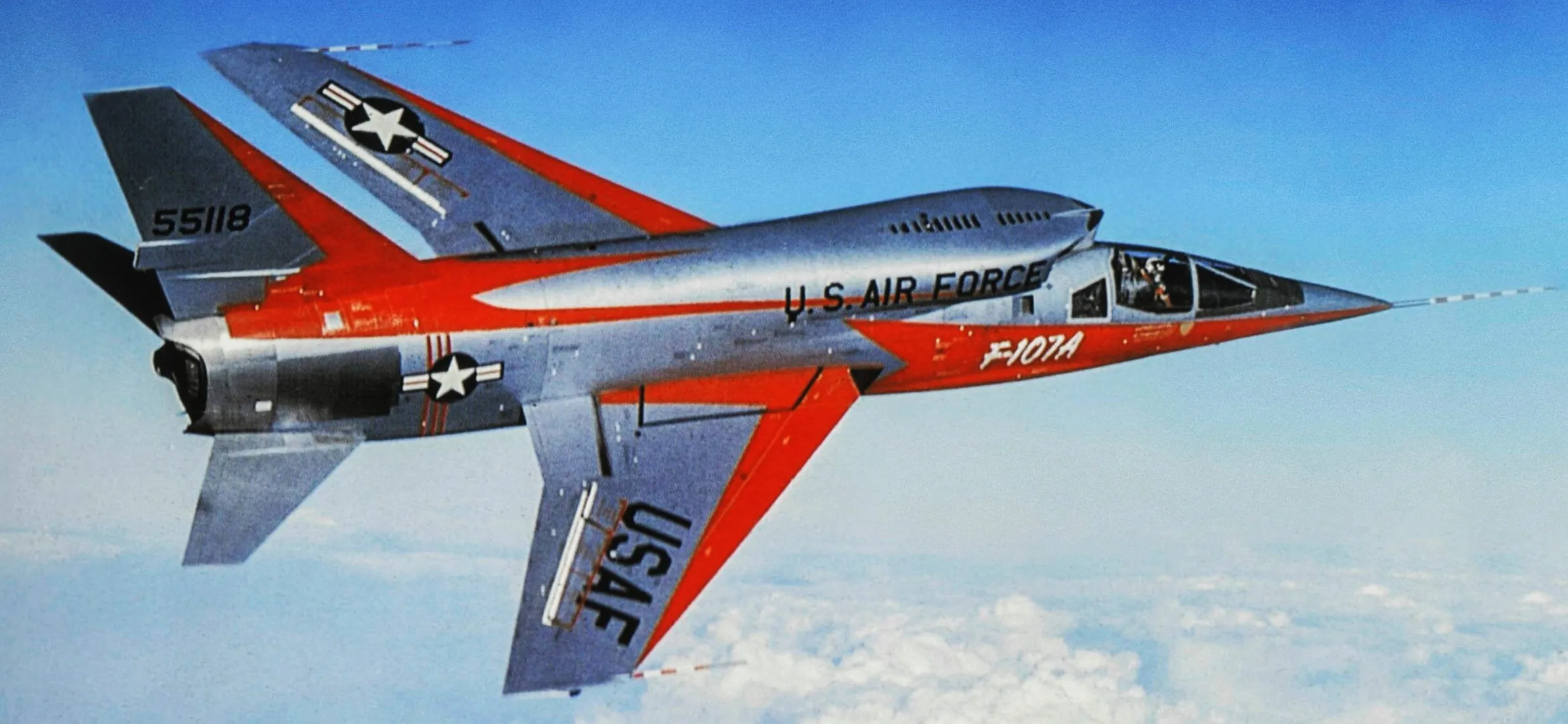Warplanes of the USA: North American F-107 Ultra Sabre
North American F-107 Ultra Sabre

(USAF Photo)
North American F-107A Ultra Sabre (Serial No. 55-05118), 212-1, 1st F-107.
The North American F-107 is North American Aviation's entry in a United States Air Force tactical fighter-bomber design competition of the 1950s, based on the F-100 Super Sabre. It incorporated many innovations and radical design features, notably the over-fuselage air intakes. The competition was eventually won by the Republic F-105 Thunderchief, and two of the three F-107 prototypes ended their lives as test aircraft. One is on display at the National Museum of the United States Air Force and a second at Pima Air and Space Museum. (Wikipedia)

(USAF Photo)
The first F-107A (Serial No. 55-5118), later NACA 207, arriving at the NASA Flight Research Center. Note the vertically-sliding canopy in open position. The first F-107A (serial number 55-5118) with North American's chief test pilot Bob Baker at the controls, made its initial flight on 10 September 1956, attaining Mach 1.03. After the successful test flight, the brakechute did not deploy, which resulted in a "hot" landing with the nose gear strut breaking. The aircraft first achieved Mach 2 in tests on 3 November 1956.

(Eric Salard Photo)
North American F-107A Ultra Sabre (Serial No. 55-05118), 212-1, 1st F-107. No. 1 is now with the Pima Air and Space Museum, Tucson, Arizona.

(Bill Abbott Photo)
In late 1957, prototypes No. 1 (Serial No. 55-5118) and No. 3 (Serial No. 55-5120) were leased to the National Advisory Committee for Aeronautics (NACA) for high-speed flight research.

(Mike Freer - Touchdown-aviation Photo)
North American F-107A Ultra Sabre (Serial No. 55-05118), 212-1, 1st F-107. Pima Air and Space Museum, Tucson, Arizona.





(Author Photos)

(Frank Kovalchek Photo)
North American F-107A Ultra Sabre (Serial No. 55-05118), 212-1, 1st F-107. Pima Air and Space Museum, Tucson, Arizona.

North American YF-107A (Serial No. 55-5119), C/N 212-2. The F-107A was a mid-1950s development of the successful F-100 Super Sabre . Special features of the F-107A included an engine air intake above the cockpit, an all-moving vertical fin, and a system (called a Variable Area Inlet Duct) that automatically controlled the amount of air fed to the jet engine. The first of three prototype F-107As flew in September 1956, attaining Mach 1 (Mach 1 is the speed of sound). A few months later, an F-107 flew at Mach 2 (twice the speed of sound). The following year, after seriously considering the production of the F-107, the USAF instead chose to buy the F-105 Thunderchief. The first and third F-107A prototypes were then leased to the NACA (National Advisory Committee for Aeronautics), predecessor to NASA (National Aeronautics and Space Administration), for high-speed flight research. The F-107A on display in the NMUSAF is the second prototype, which was used for weapons testing with both conventional and atomic bombs. It was flown to the museum when the program ended in 1957. (NMUSAF)
.webp)
(Judson McCranie Photo)
North American YF-107A (Serial No. 55-5119), C/N 212-2, National Museum of the USAF, Dayton, Ohio.

(NMUSAF Photo)
The second F-107A ( Serial No. 55-5119), made its first flight on 28 November 1956. It was used for weapons testing with both conventional and atomic bombs.

(NMUSAF Photo)
Prototype No. 2 (Serial No. 55-5119) was not used by NACA and flown on 25 November 1957 to the National Museum of the United States Air Force at Wright-Patterson Air Force Base near Dayton, Ohio.


(NMUSAF Photos)
North American YF-107A (Serial No. 55-5119), C/N 212-2. The F-107A was a mid-1950s development of the successful F-100 Super Sabre . Special features of the F-107A included an engine air intake above the cockpit, an all-moving vertical fin, and a system (called a Variable Area Inlet Duct) that automatically controlled the amount of air fed to the jet engine. The first of three prototype F-107As flew in September 1956, attaining Mach 1 (Mach 1 is the speed of sound). A few months later, an F-107 flew at Mach 2 (twice the speed of sound). The following year, after seriously considering the production of the F-107, the USAF instead chose to buy the F-105 Thunderchief. The first and third F-107A prototypes were then leased to the NACA (National Advisory Committee for Aeronautics), predecessor to NASA (National Aeronautics and Space Administration), for high-speed flight research. The F-107A on display in the NMUSAF is the second prototype, which was used for weapons testing with both conventional and atomic bombs. It was flown to the museum when the program ended in 1957. (NMUSAF)

(NASA Photo)
The third prototype North American F-107 (Serial No. 55-5120) at Edwards AFB, California in 1959.
The last prototype, (Serial No. 55-5120) had its maiden flight on 10 December 1956. At the conclusion of the F-107A's successful test program, the Tactical Air Command decided to hold a fly-off competition between the F-107A and the Republic F-105 Thunderchief which was designed to same mission requirements and used the same engine. Although the competition was close, the F-105 was selected as the new standard TAC tactical fighter. The three F-107A prototypes were relegated to test flying and the pre-production order was cancelled. In September 1959, with Scott Crossfield at the controls, aircraft #3 was damaged during an aborted takeoff. The aircraft was not repaired and, ultimately, used for fire fighting training and was destroyed in the early 1960s. (Wikipedia)

(NASA Photo)
The third F-107A parked on the ramp at the Flight Research Center, 7 Jan 1959.





